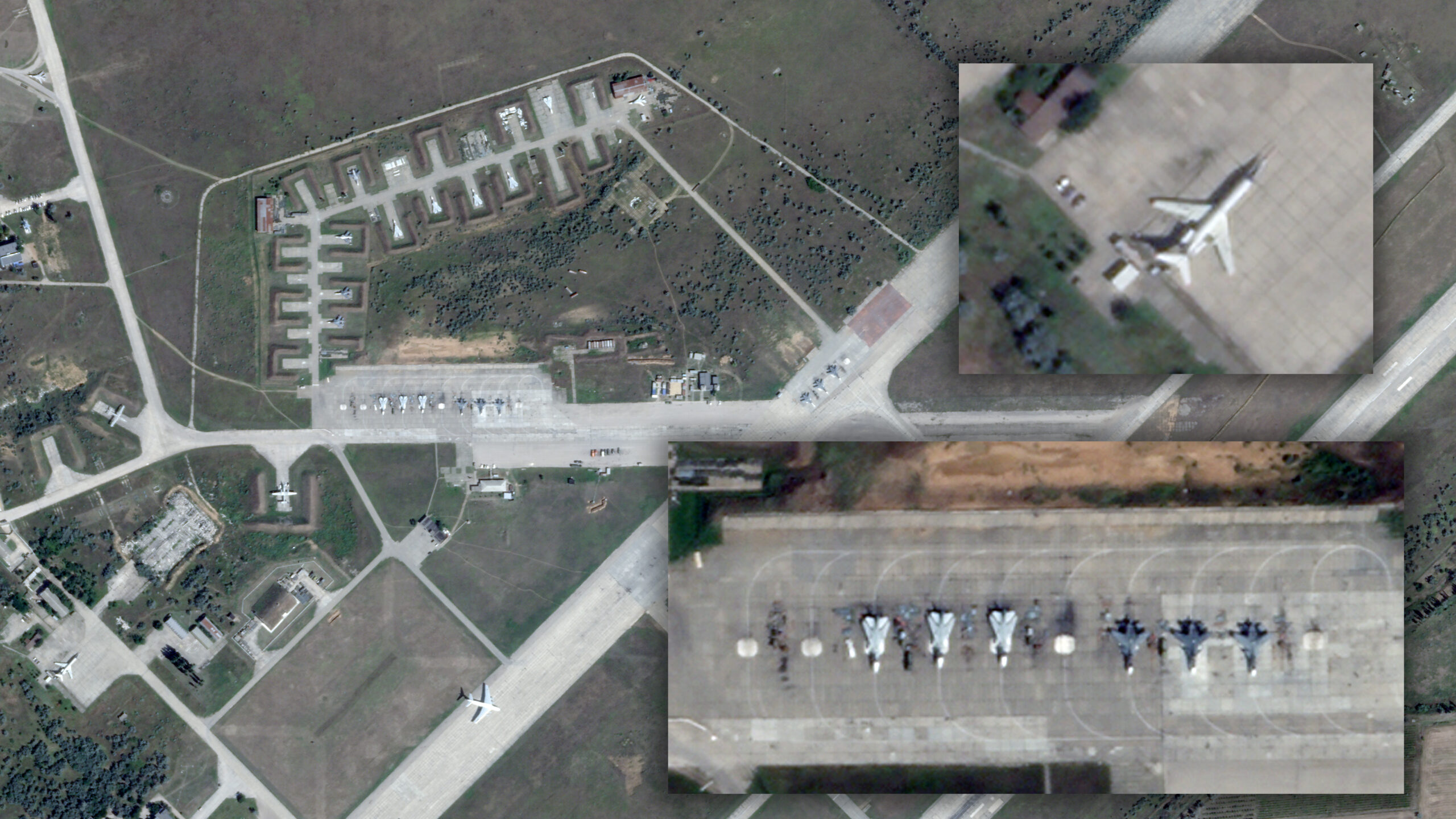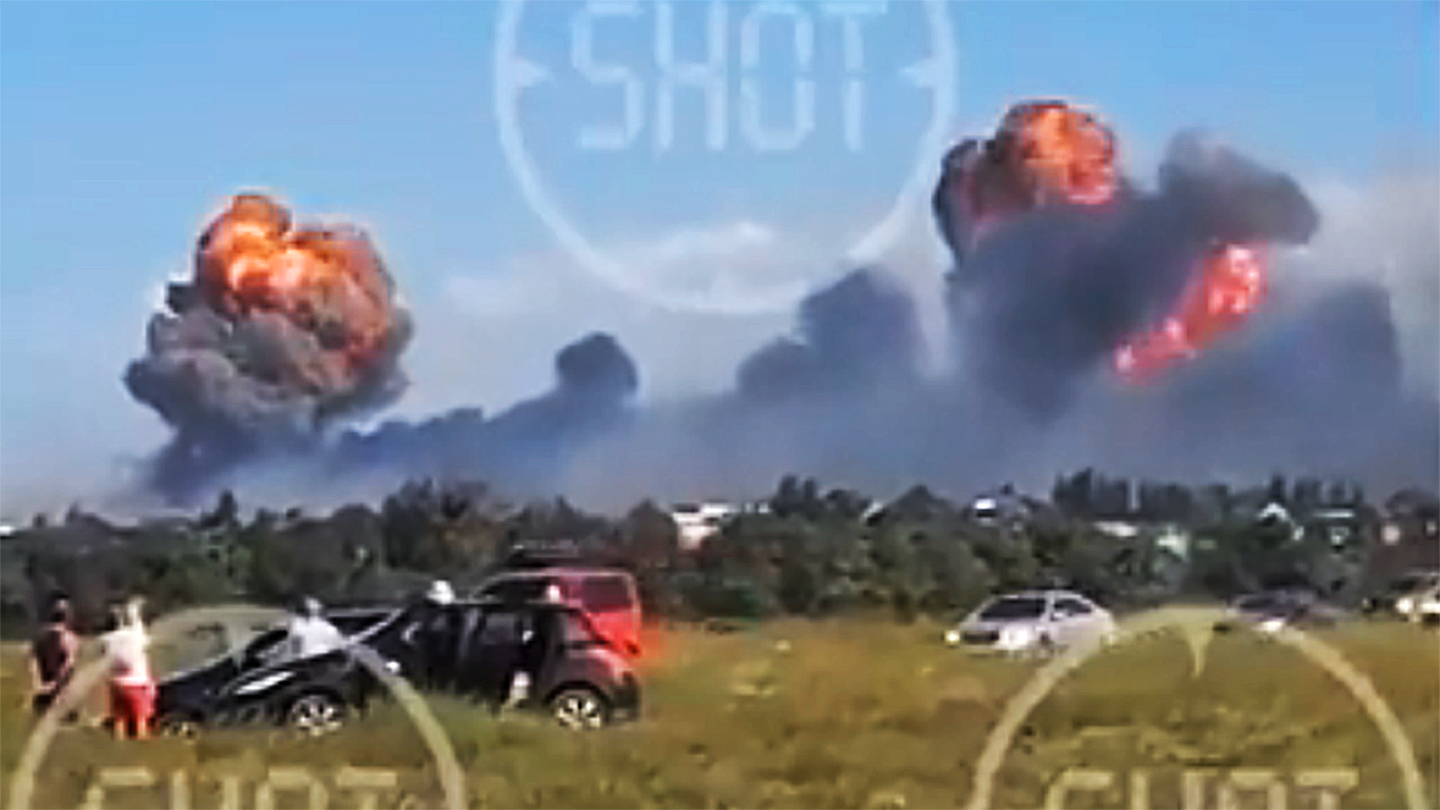As images of large explosions in Russian-occupied Crimea flashed across social media, the Russian Ministry of Defense on Tuesday claimed they were the result of “several aviation munitions destroyed” at the Russian Navy’s Saki Air Base near the village of Novofedorivka.
The incident occured about 3:20 p.m. local time, according to an official Ministry of Defense (MOD) statement.
“As a result of the explosion, no one was injured. Aviation equipment at the airfield was not damaged,” according to the MOD’s statement. “Measures are being taken to extinguish the fire and find out the causes of the explosion. According to a report from the site, there was no fire impact on the bunded ammunition storage area at the airfield”
A senior Ukrainian military official with knowledge of the situation told The New York Times that Ukrainian forces were behind the explosion.
“This was an air base from which planes regularly took off for attacks against our forces in the southern theater,” the official said, speaking on the condition of anonymity to discuss sensitive military matters. The official would not tell the Times what type of weapon used in the attack, saying only that “a device exclusively of Ukrainian manufacture was used.”
A top Crimean official earlier on Tuesday confirmed there were several explosions in Novofedorivka.
“So far, I can only confirm the very fact of several explosions in the Novofedorivka area. I ask everyone to wait for official messages and not to produce versions. Oleg Kryuchkov, adviser to the head of Crimea, said on Tuesday on his Telegram channel.
Viktoria Kazmirova, deputy head of the administration of the Saki district, also reported explosions at the airfield, according to Russian state-run media outlet TASS.
“Our airfield is exploding. Explosions at the airfield. Here all the windows were broken,” Kazmirova said.
The regional health ministry “reported that ambulances and medical aviation were sent to the site of the explosions, information about the victims is being specified.”
Saki Air Base, which Russia occupied when it took over Crimea in 2014, is home to the Russian Navy’s 43rd Independent Naval Attack Aviation Regiment (43 OMShAP). This regiment flies 12 Su-30SMs, six Su-24Ms, and six Su-24MRs, and came to prominence during several encounters with NATO forces in the Black Sea in 2021.
U.S. officials have told The War Zone in the recent past that targets in Crimea are fair game for Ukrainian forces using advanced U.S. weapons. The U.S. sees Crimea as illegally occupied by Russia and no different than the territory it holds in eastern Ukraine. As such, all military targets are fair game, as well as critical infrastructure it relies on to keep its war machine and occupation efforts running.
While some Ukrainian officials claim their military carried out an attack on the base, it is not unheard of for major accidents at Russian ammunition supply depots to occur, although the chances of that being the case are relatively slim in this instance.
However, Novofedorovka is about 124 miles (200 kilometers) from the front lines.
The Saki Air Base seems to be well beyond the range of Ukraine’s long-range fires.
Ukraine has 16 M142 High Mobility Artillery Rocket Systems, or HIMARS, provided by the U.S. as well as three M270 systems provided by the United Kingdom.
Both can fire a variety of 227mm rockets, including Guided Multiple Launch Rocket System (GMLRS) types made by Lockheed Martin, as well as the Army Tactical Missile System (ATACMS) short-range ballistic missiles. So far, the U.S. has only provided Ukraine with an unpublicized amount of M31 rockets with 200-pound class unitary warheads, which are GPS/INS guided and can hit targets at a distance of around 43 miles (70 kilometers.) The Biden administration is reluctant to provide longer-range and harder-hitting ATACMS out of concern that it might rile the Russians. In particular, it could provide a means for Ukraine to execute precision strikes on a large variety of targets well into Russia.

The U.S. has provided M982 Excalibur guided projectiles for the M-777 howitzers, which have a range of about 24 miles.
Both the United States and Denmark have also donated a number of RGM-84 Harpoon anti-ship missiles and shore-based launchers to Ukrainian forces. The RGM-84 missile uses active radar homing to detect and track targets and boasts a range of up to 67 miles under optimal circumstances, but there is no point in Ukrainian territory not held by Russia anywhere near that distance to the air base.
Advanced Harpoon variants and those modified to carry a smaller warhead and more fuel are able to make nearly triple that range, but it is not clear if Ukraine has this capability. If they do not, it’s not clear how Ukraine would employ its only foreign standoff missile, or even its locally-designed Neptune counterpart, against the airbase unless a clandestine operation was executed, where the Harpoon was launched at sea within range or from a concealed vehicle within Russian territory. Using these missiles to hit land targets is also an ‘off label’ use that could be challenging to achieve reliably.
The attack also appears to be beyond the range of Ukraine’s Tochka-U Short-Range Ballistic Missile system, which has a range of about 75 miles in its most updated version.
Ukraine, however, has been known to carry out sabotage raids inside Russian territory. This is in addition to a shadowy capability where large off-the-shelf drones are converted into very low-end cruise-like missiles. These have been used to hit strategic targets in Russia and remain unacknowledged, formally at least, by Ukrainian officials. Such weapons have proven their ability to fly deep into highly defended territory to strike targets of great importance. You can read all about this improvised system in this previous article of ours.
This late in the conflict, Ukraine could have also created or adapted a new weapon capable of long-range strikes, especially with some external help. Ukrainian Air Force, with anti-radiation missile capability, means that it can potentially expand its tactical operations, although attacking this airfield in highly defended Crimea would be a reach. But this could have come from a far less advanced capability, as well.
While the attack on arguably Russia’s most critical airbase in Crimea is new, striking at the heart of Russia’s war machine on the annexed peninsula is not. On August 1st, the Black Sea Fleet’s headquarters was targeted in a localized suicide drone attack. As we stated at the time, this was likely a sign of what’s to come on the annexed peninsula and today certainly validated that notion. With Ukrainian operatives working in Crimea, even small artillery rockets from makeshift launchers could put ammunition dumps like these at risk behind enemy lines.
The Russians have placed a tremendous amount of air defense resources in Crimea, in no small measure to defend against attacks on critical infrastructure, such as the Kerch Bridge, as well as military installations. If indeed this attack came via the air, and especially not by a hard-to-intercept ballistic missile, it serves as another stunning rebuke of Russia’s much-vaunted air defense capabilities.
Regardless, by most indications, it seems increasingly clear that the war has arrived far south on the occupied Crimean Peninsula. How this potential reality could morph the conflict is yet to be seen.
We have reached out to sources in Ukraine and the Pentagon for comment. We will update this developing story as more information becomes available.
Contact the author: howard@thewarzone.com
Update 8/9 2:19 p.m. EST
It appears that a Russian Ilyushin Il-76 Candid airlifter was taxiing as the explosions were going off at Saki.
According to the most recent information provided by the Telegram channel of Russia’s TASS news agency, one person died and seven were injured during what it is says was “the detonation of aviation ammunition on the territory of the Saki airfield.”
On its website, TASS cites a Russian MOD source who said the explosions were the result of “violations of fire safety rules.”
“Only violations of fire safety rules are considered as a key cause of the explosion of several munitions,” the Russian MOD source told TASS. “There are no signs or evidence that it was done deliberately.”
While it is possible this was an accident, and they have certainly happened before, quickly explaining away incidents like this in such a manner is a familiar Russian refrain.
However, officials in Crimea have issued a high-level terrorist threat alert there until Aug. 24, TASS reported on its Telegram channel, citing regional official Sergei Aksyonov.
The area is a popular vacation spot, and many folks enjoying the day found their plans abruptly changed.
Ukraine’s Ministry of Defense, meanwhile, trolled the Russians.
Update 8/9 3:15 p.m. EST
Despite Russian claims that no aircraft were damaged in the explosion at Saki, video is emerging on social media that appears to show that is not that case. One video appears to show a completely destroyed Russian Su-24 Fencer swing-wing attack jet.
Although this cannot be confirmed at this time, if the many aircraft are damaged and destroyed, it would raise the significance of the attack.
Update 8/9 4:45 p.m. EST
More video that supposedly shows the aftermath of the attack has surfaced:
Meanwhile, The War Zone has obtained a satellite image from Planet Labs showing the base this morning prior to destruction. There are a few interesting details.
The video showing the destruction of the Su-24 on a flight line with a blast wall behind it, as well as what looks like a burned-out Su-30 in the background appears to be the main apron seen below. If that is the case, it is likely Russia lost multiple Flanker derivatives and Fencers in the strike just based on what was on the ramp in the morning (three Su-30s and three Su-24s) alone. Other areas and aircraft were also likely impacted, as well, including multiple other nearby tactical jets seen in the satellite image.

Also of note is the presence of what appears to be a Tu-134UBL on the ramp (also seen inset into the satellite image above). These aircraft work as navigation and radar crew trainers for the Tu-22M and Tu-160 fleet, but a couple of them have also been converted into VIP transports for the head of the Black Sea Fleet and the Northern Fleet. Our friend @OSINTtechnical mentioned the aircraft’s presence at the airfield before the attack. Recent imagery shows the aircraft coming in and going over the last year and it may be at least partially forward-deployed, if not based there. It most recently showed up in late July and was on the ground this morning. The aircraft could also be one of the normal Tu-134UBL types and at the base for training or to support Russia’s ongoing maritime mission in the northern Black Sea region. Whatever the case, it is a unique aircraft.

Meanwhile, it seems that many tourists and other folks want to get out of Crimea after the strike, with major traffic jams occurring around the Peninsula, including across the Kerch Strait Bridge which would be considered a top target for Ukrainian forces if they can reach it.
Update:
You can find our latest coverage regarding the explosions at Saki Air Base on August 9 here.
The War Zone has also explored in detail what we know of the possibility that Ukrainian forces might have struck the base using domestically-developed short-range ballistic missiles, as you can read more about here.
Contact the author: howard@thewarzone.com
